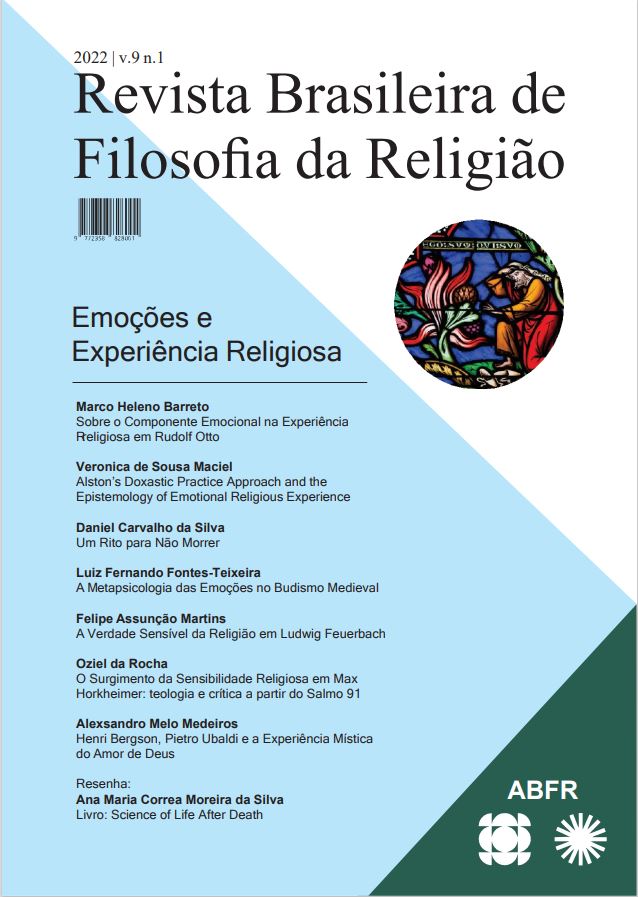THE METAPSYCHOLOGY OF EMOTIONS IN MEDIEVAL BUDDHISM
DOI:
https://doi.org/10.26512/2358-82842022e44278Keywords:
Buddhism, Emotions, Impermanence, MedievalAbstract
This article approaches the metapsychology of emotions in Medieval Buddhism. The main goal is to sustain the hypothesis that the place and the role of the emotions suffer a displacement in the medieval reception of Buddhist teachings. If at first—in its origins—Buddhism understands that emotions are something to be controlled, manipulated, or even avoided, throughout the Middle Ages they become rather a tool for the cultivation of attention to one of the most important marks of existence, namely, the impermanence. To reach this goal, the following steps are taken: (i) in the first place, identifying, within the originary Buddhist vocabular, which terms come closer to the general concept of emotion; (ii) then, presenting the place of emotions in the origin of Indian Buddhism (iii) by the end, exploring the role of the emotions in Medieval Buddhism, based on the dialogue with Chinese philosophy and Japanese literature, emphasizing the Mahayana tradition.
Downloads
References
ASANGA (1998). The Abhidharmasamuccaya. 3. ed. Trad. Traleg Kyabgon. Victoria: Kagyu E-Vam Buddhist Institute
BECK, Burchard J. Mansvelt (1986). “The fall of Han” in The Cambridge History of China: Volume 1: The Ch’in and Han Empires. Cambridge: Cambridge University Press: 317–376.
BHIKKHU BODHI (2005). The Connected Discourses of the Buddha: A New Translation of the Samyutta Nikaya. 2. ed. Somerville, MA: Wisdom Publication.
BILLIMORIA, Purushottama e Aleksandra Wenta (2015). “Introduction” in Emotions in Indian Thought, ed. Purushottama Billimoria & Aleksandra Wenta. London: Routledge: 1–54.
BRUYA, Brian (2001) “Qing and Emotion in Early Chinese Thought”. Ming Qing Yanjiu: 151–176.
CHOWDHURY, Chipamong (2009). “Did the Buddha Speak Pali?” The Dhaka University Journal of Linguistics. 2, 4: 43–57.
DE SILVA, Padmasiri (2006). The Psychology of Emotions in Buddhist Perspective. Kandy: Buddhist Publication Society.
DEMIÉVILLE, Paul (1986). “Philosophy and religion from Han to Sui” in The Cambridge History of China: Volume 1: The Chin and Han Empires. Cambridge: Cambridge University Press: 808–872.
DOGEN (1985a). “Actualizing the Fundamental Path” trad. Robert Aitken e Kazuaki Tanahashi, in Moon in a Dewdrop: Writings of Zen Master Dogen, ed. Kazuaki Tanahashi. Berkeley, CA: North Point Press: 69–73.
DOGEN (1985b). “Birth and Death” trad. Arnold Kotler e Kazuaki Tanahashi, in Moon in a Dewdrop: Writings of Zen Master Dogen, ed. Kazuaki Tanahashi. Berkeley, CA: North Point Press: 74–75.
DOGEN (1985c). “The Moon” trad. Mel Weitsman e Kazuaki Tanahashi, in Moon in a Dewdrop: Writings of Zen Master Dogen, ed. Kazuaki Tanahashi. Berkeley, CA: North Point Press: 129–133.
FREUD, Sigmund (1996). Obras psicológicas completas de Sigmund Freud: edição standard brasileira; volume XIV. Trad. Jayme Salomão. Rio de Janeiro: Imago.
GRAHAM, Angus C. (1990). “The Background of the Mencian Theory of Human Nature” in Studies in Chinese Philosophy and Philosophical Literature, ed. Angus C. Graham. Albany, NY: State University of New York Press: 7–66.
GRIFFITHS, Paul (2006). “A Meditação Budista na Índia” in Espiritualidade budista: Índia, Sudeste Asiático, Tibete e China primitiva, ed. Takeuchi Yoshinori, trad. M. C. Cescato. São Paulo: Perspectiva: 37–71.
HARRISON. Victoria S. (2019). Eastern Philosophy: The Basics. 2. ed. London: Routledge.
HARTMANN, Jens-Uwe (2004). “Languages” in Encyclopedia of Buddhism: Volume 1, A-L, ed. Robert E. Buswell Jr. New York: Thomson Gale: 452–456.
HEINE, Steven (1998). “Motion and Emotion in Medieval Japanese Buddhism” Journal of Chinese Philosophy. 25: 191–208.
JAMES, William (2013). “O que é uma Emoção?” Trad. Raphael Silva Nascimento. Clínica & Cultura. 2: 96–113.
KARPIK, Stefan (2019) "A Reply to Brian Levman's The Language the Buddha Spoke" Journal of the Oxford Centre for Buddhist Studies. 17: 106–116.
LAI, Whalen (2006). “As Três Jóias na China” in Espiritualidade budista: Índia, Sudeste Asiático, Tibete e China primitiva, ed. Takeuchi Yoshinori, trad. M. C. Cescato. São Paulo: Perspectiva: 303–376.
LEVMAN, Bryan (2016) “The language of early Buddhism” Journal of South Asian Lan-guages and Linguistics. 3, 1: 1–41.
MANUSMRITI (1886). The Laws of Manu. Trad. George Buehler. Oxford: Clarendon Press.
MONIER-WILLIAMS, Monier (1899). A Sanskrit-English Dictionary. Oxford: Clarendon Press.
NYANAPONIKA Thera (1995). “The Place of Feeling in Buddhist Psychology” in Contemplation of Feeling: The Discourse-Grouping on the Feelings. Trad. Nyanaponika Thera. Kandy: Buddhist Publication Society: 4-5.
PANDE, Govind C. (2006). “A Mensagem do Buda Gautama e suas Primeiras Interpretações” in Espiritualidade budista: Índia, Sudeste Asiático, Tibete e China primitiva, ed. Takeuchi Yoshinori, trad. M. C. Cescato. São Paulo: Perspectiva: 3–36.
SEOK, Bongrae (2021). “The Emotions in Early Chinese Philosophy” The Stanford Encyclopedia of Philosophy. Disponível em: https://plato.stanford.edu/entries/emotions-chinese/.
THURMAN, Robert A. F. (2006). “Monasticismo e Civilização” in Espiritualidade budista: Índia, Sudeste Asiático, Tibete e China primitiva, ed. Takeuchi Yoshinori, trad. M. C. Cesca-to. São Paulo: Perspectiva: 133–149.
VAJRACCHEDIKA PRAJNAPARAMITA (2006). “Vajracchedika Prajnaparamita: A New English Translation of the Sanskrit Text Based on Two Manuscripts from Greater Gandhara” trad. Paul Harrison. Buddhist Manuscripts: volume III, ed. Jens Braavig. Oslo: Hermes Publishing: 142–159.
VEDANA-SAMYUTTA (1995). Contemplation of Feeling: The Discourse-Grouping on the Feelings. Trad. Thera Nyanaponika. Kandy: Buddhist Publication Society.
YAMAMURA Kozo (2008). “Introduction” in The Cambridge History of Japan: Volume 3, Medieval Japan, ed. Kozo Yamamura. Cambridge: Cambridge University Press: 1–45.
Downloads
Published
How to Cite
Issue
Section
License
Copyright (c) 2023 Brazilian Journal for Philosophy of Religion

This work is licensed under a Creative Commons Attribution 4.0 International License.

